Courtesy Of Trevor Amos.
Time and timing again, but in this case, focusing on maximum brake torque timing (MBT), which could be described as, the minimum ignition timing advance needed to achieve the best torque and power values throughout the engine`s rev band, together with a dependable degree of reliability, At least that`s the way I see it. All engines derive their energy from the heat released during combustion, and as the processes inside the cylinder for each single cycle are merely transient, then optimising these within the time scale available is critical to delivering the best available torque and efficiency. Combustion could therefore be defined as, a time-dependent release of thermal energy from a chemical reaction. This important, adjustable timing element should become a vital constituent of any serious tuners armoury. The graph below shows very clearly the effect that ign. timing makes to torque production. This engine was run continuously at 5,000rpm with the timing being adjusted, and the engine produced a BMEP output of 8bar. The right hand image shows cylinder pressure set against varying degrees of ignition timing. Both illustrate the reality of optimal ign. timing set against crank rotation.
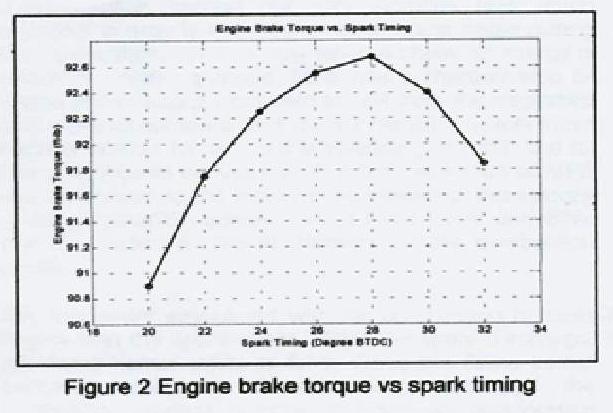
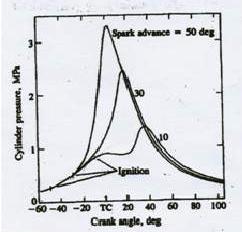
The performance of a Bantam engine is hugely influenced by the ign. curve, but in the case of fixed timing, there is no curve, so inevitably there will be a significant compromise between peak power and mid- range requirements, either way there is a measurable loss to be incurred. Our 3speed gear box does us no favours in this respect, where the engine`s power band must be as broad as possible to compensate for the insufficient number of ratios. Being able to use a retarding ign. boosts output at low rpm, effectively broadening the engine`s operating range, and, provides for reliability at higher rpm and power. Further consideration can therefore be taken of exhaust system functions, and that also, can have additional impact with enhanced performance, where these features all work in concert to maintain effective power well past the peak torque point and into over rev. By retarding the point of ign., combustion begins closer to the point of exhaust port opening, without the need for a high port, so the ex. gas is hotter, is travelling faster and has more energy.
The faster the bulk combustion gas exits the cylinder, in any given time scale, so the greater and purer the scavenging charge can be, and that is a real bonus. However, as revs rise towards a peak, and beyond, so the time available for this to happen is reducing and scavenging begins to drop off, so mixture purity falls, temps go down, the pipe cools and everything goes to hell! By being able to further allow the ign. to retard, more heat can go into the pipe, to maintain correct acoustic wave speed, thus power, for a short extended period. At the same time, unwanted, spent gas can exit the pipe more effectively in time for the next cycle. But, retard too much too early in the rev cycle and dump an excess of heat into the pipe, which should have its` tuned length calculated for a prescribed pipe temp, and a certain wave and engine speed, and that tuned length will, effectively, be changed. And, as the wave speed propagates at the local speed of sound and is proportional to the square root of the mean gas temperature, it can have a definite effect.
Wave influence can be most significantly felt in reed valve engines, where the exhaust system directly affects the reed movement. Here, the reeds can be persuaded to open shortly after bdc, and close in response to rising case pressure! It is worth bearing in mind that as the pipe temperature varies with every step change of a few mm, together with pipe pressure and geometry, and diameter in particular, landing on realistic data to input to your favourite pipe construction equations can get a little complicated, confusing, and at times, self- defeating!
Below is the ign. timing graph of a typical modern race engine.
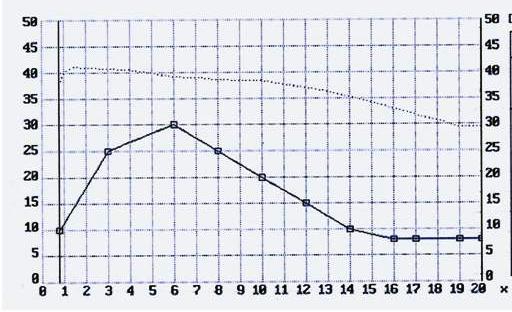
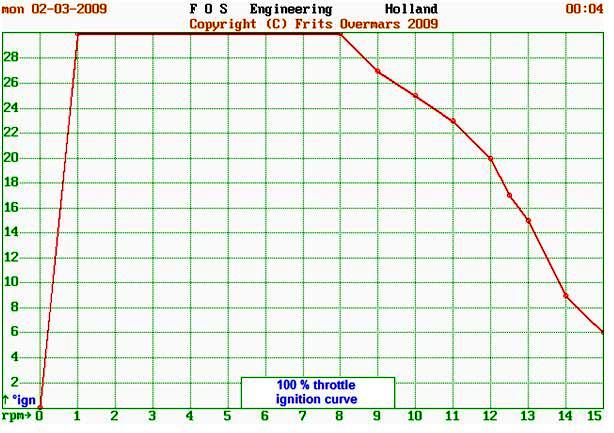
Above is a timing plot of the Aprilia engine, it is doubtful if a Bantam engine would survive very long with that degree of advance, such are the engine systems management and cooling efficiency of that machine !
The start of combustion must be correctly related to TDC in order to obtain optimum power and torque. At any engine speed, torque varies as the timing point moves relative to TDC. If the start of this process is progressively advanced from TDC then the stroke work energy is increasingly transferred from the piston to the cylinder gas. Conversely, if the timing is retarded then work energy is transferred from the gas to the piston. However, irrespective of piston direction and provided there is combustion, cylinder pressure will rise so we need the piston to be in the right place at the right time. Only after combustion has finished can expansion of the burnt gas be fully realised. The optimum MBT timing is that which balances out these two opposing, negative and positive, tendencies, and timing either side of this only offers the prospect of lower torque, so there will be an ignition timing point that yields the maximum work for a given air to fuel mixture. The chemical make-up of the fuel, with its reaction to both temperature and pressure and it`s combining with available oxygen (denser mixture means more oxygen, mixture mass, and more combustion power in each engine cycle), in the ideal stoichiometric ratio, that will determine the final engine performance.
The combustion cycle takes real time to get underway, (from initial laminar to full on turbulent burn) and then to complete, indeed, to the first real sign of combustion up to 10* of crank rotation may have taken place from initiation. Laminar flames have a velocity of around half a meter per second to, extreme, detonation flames at a rate of a couple of thousand meters per second, with all of this happening within the same pre-mix of fuel vapour, air and residual burned gasses. The effect of turbulence is to accelerate the burning rate by increasing the burn surface area. As the combustion chamber volume and shape are constantly changing (actually, not quite true for tdc and more so for 175s), the critical ign. points set against crank angle could compromise the actual amount of useful work available, for a 64mm bore and 8-1 cr differs importantly from a 54mm bore with a 14-1 cr, for instance. Just calculating the respective cylinder wall surface areas of 1mm of stroke illustrates dramatically the heat soak potential of the larger bore and head surfaces!
The actual combustion flame path travel distance, hence time, of a larger bore diameter and deeper combustion chamber places the larger capacity Bantam engine at a clear disadvantage over its smaller brother. The rate of burn increases from the low, laminar value just after spark discharge, up to a maximum about half way through the process, slowing to zero as the combustion flame is quenched at the cool cylinder wall. Commonly, the 50% burn period can be found to be in the region of 10-20*ATDC, with the piston accelerating rapidly away from TDC. Engine geometry comparisons between the current 175 and 125 engines differ enough to make the respective acceleration rates significant enough to have to rethink these fundamental similarities.
The images below are part of results data on a Yamaha engine extensively tested at QUB, and these results we can all identify with as the rpm level is consistent with Bantam engines. I have cleaned the pictures up by removing unnecessary academic clutter and included a couple of explanatory headings, 10,350rpm is about the mid-point of the engine`s power band width. Further data from testing showed that the 50% burn angle coincided closely with the point of peak cylinder pressure, and that as revs rose to their maximum of 12,300, so the 50% max fraction burned position was increasingly delayed past TDC. The same tendency is seen when the compression ratio is dropped by a value of 1.2, the lower cr means a slower burn rate and at the 12,300 rpm level the peak cylinder pressure was delayed by a further 2*. One thing is thus made quite clear, any modification made will always influence more than one operating parameter.
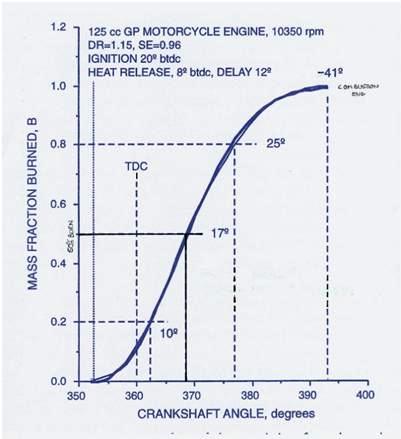
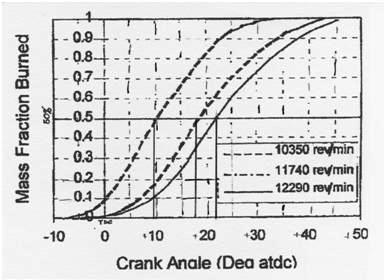
As always, there are caveats, and compromises to be considered in all events in the real world of highly stressed race engines, particularly in the case of thermally challenged iron ones, and air cooled in general. Clearly the water cooled variants are at an advantage where cooling efficiency can be readily adjusted with pumping rates and/or radiator choice. Well known is the fact that for every drop of 10c*or so in water temp brings a power increase. This feature alone could allow for a more favourable adjustment to ign. timing points to achieving MBT. It is indeed, a very tricky challenge to get a 10* temperature drop with an air cooled Bantam barrel when attempting to achieve a power increase, particularly as there is no real gain in air flow cooling potential.
The number of permutations involved in engine development is immense, and it seems that most are worse and the last makes no difference!
It may be that the ideal timing will produce too favourable an output and the extra heat generated proves troublesome to dissipate effectively. In much the same way then, a static timing that gives best midrange could self-destruct the engine in pretty short order at sustained peak rpm output, where the combination of excessive advance and subsequent rapid heat build-up, overwhelms cylinder`s cooling ability.
Cylinder pressure continues to rise significantly after the piston finally seals the exhaust port, in a good motor this could, just, be approaching 1.5bar, the pressure ultimately achieved will depend on how well the remainder of the engine breathes. The higher the engine`s trapping efficiency and delivery ratio, the bigger the bang! This leads to the concept of dynamic compression, ie, the static geometric ratio added to the TE and DR, and the greater the sum of these, the less timing advance the engine will tolerate because…. power is heat is power, with heat being the real killer with Bantams.
Here are a few raw statistics illustrating the Aprilia cylinder pressures calculated at peak power rpm, of 13,250/13,500 Ex close……2.4bar Ign point…..34bar Tdc…..54bar Peak….62bar at 20*Atdc Combustion complete at 40*Atdc .
One absolute requirement to enable those sorts of numbers to be achieved is a very powerful ign. spark of long duration, because not all discharge energy is actually passed to the spark, a significant amount is lost as heat, additionally the system must perform faultlessly, and repeatedly so, in the finite time scale and high pressures that exist at 13,000+rpm. It is quite amazing to consider the mechanisms that enable the cylinder pressure rise that takes place in the short distance of piston travel from trapping to ign. point and then up to TDC and beyond!
As combustion in any spark ign. engine is a combined chemical, electrical and physical process it follows that the differing geometries between 125(short rod/stroke) and 175/190(long rod/stroke) configurations of current Bantam engines have a considerable bearing on their respective potential performances. The cyclical compression and expansion processes need to be fully completed as rapidly as is possible. This will enable the maximum amount of chemical energy, that produces heat and pressure from expansion of the burning fuel, to be conserved then transferred to the piston crown to produce work. Implicit in this is the correct choice of fuel that can maximise overall performance. It would seem that most competitors use Avgas as their first choice for race fuel, but as best performance is achieved with a rapid burning fuel, that choice imposes restrictive ign. timing selection, for avgas is not a fast burner, and that alone could, pre-select, ignition advance, and particularly so for single point ignition systems. It is then, beneficial, to have a fast, turbulent combustion, the ignition point can start later, and heat energy losses will be much smaller.
The 90% evaporation point of Avgas 100LL is 135*c whereas the 90% point of, for instance, VP C12 race gas is only 105*c. also, C12 has a higher density, these are just a couple of indicators to illustrate what Avgas doesn`t do for you. The best that could be said in its favour in this comparison is that it is safe, has dependable, consistent quality, is cheap and is allowed, and will be better than pump gas! But it is wise to remember that it is fuel vapour that burns and not the liquid fuel and that combustion takes place only after the vaporisation process is well underway. Sunoco, of America, being a major producer of aviation fuels, offers the following warning to those considering avgas for a high rpm situation, “Don`t do it“! During aviation use there is no need for transient throttle response, rpm is set at around 3,000 for 4T light-plane piston engines and usually stays there until landing.
The conditions encountered in flight include low temperatures, low atmospheric pressure, and the burn rate,( the speed at which fuel releases its energy), is too slow for any effective high performance 4T automotive use, never mind a high rpm two stroke race engine pushing at 10,000rpm. Be that as it may, avgas with its high octane rating and lead content, does delay the onset of detonation when compared to pump gas, so the tuning envelope can be pushed a little higher with some confidence. But as always, the choice lays with the end user!
With the piston crown being the hottest component in the engine, internal heat loss caused by fuel vaporization, produced during compression and just before combustion begins, is the piston`s gain, where the crown is measurably cooled and can therefore survive a little better in its hostile environment. The reason petrol always feels cold, even in high summer, is that heat is continually being dissipated by the effect of its Latent Heat of Vaporization, a phenomenon that can be used to our engine`s advantage.
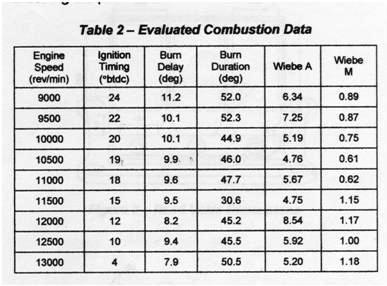
The above table is the result of testing a Honda RS125 engine, in a similar fashion to the earlier Yamaha, and provides for comparison and confirmation of the general trend for the value of selecting a suitable ign. curve. There is one anomaly at 11,500 RPM, where the burn duration is significantly reduced, there is no direct explanation for this in the text of the paper from where this data is taken from. However, with one of the exhausts that was tested both the bmep and delivery ration were much lower at 11,500rpm which would explain the shorter burn cycle, after all, if there is little gas in the chamber it won`t take long to burn it? Confusingly, the chart data was stated to have been collected using the standard Honda pipe, and with this the bmep and delivery ratio held up, so perhaps a typo crept in here?
The-S-shaped curve referenced in the mass fraction burned graphs is commonly used to describe the combustion process, it`s profile starts at zero, the beginning of the burn, and finishes at the end of combustion at 1, the difference between the two being the burn duration. Countless books and research papers from over the world use this mathematical, heat release model to describe combustion rates, the Weibe function, be it two or four stroke, so some confidence can be place upon its usefulness.
